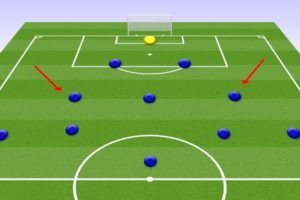Developing a Strong Understanding: The Partnership Between Centre-Backs
When it comes to soccer, the partnership between centre-backs is crucial for the success of a team. Developing a strong understanding between these players can make all the difference in the outcome of a game. In this article, we will explore the various ways in which centre-backs can work together to create a solid defense and build up play.
One of the key elements to a successful centre-back partnership is communication. By constantly communicating with each other, centre-backs can ensure that they are on the same page and can react quickly to any changes on the field. This can involve calling out to each other to mark players, making sure they are in the right position, and communicating when to press or drop back.
Another important aspect of a strong centre-back partnership is understanding each other’s strengths and weaknesses. By knowing each other’s playing styles and tendencies, centre-backs can complement each other’s skills and cover for any weaknesses. This can involve one player taking a more aggressive approach while the other covers defensively, or one player pushing forward with the ball while the other drops back to provide support.
Communication
Effective communication is key to developing a strong partnership between centre-backs. There are two main types of communication that can be used to improve understanding between players: verbal and nonverbal.
Verbal Communication
Verbal communication involves speaking to your partner during the game. This can be used to give instructions, provide feedback, or offer encouragement. It is important to keep communication concise and clear, as too much talking can be distracting and confusing. Some examples of verbal communication include:
- Calling out the name of your partner to get their attention
- Instructing your partner to mark a particular player
- Letting your partner know when you are going to challenge for the ball
By using verbal communication effectively, centre-backs can ensure that they are on the same page and working towards the same goals.
Nonverbal Communication
Nonverbal communication involves using body language and other nonverbal cues to communicate with your partner. This can be particularly useful when there is too much noise on the pitch or when you don’t want to give away your intentions to the opposition. Some examples of nonverbal communication include:
- Making eye contact with your partner to signal that you are ready to receive a pass
- Pointing to a particular area of the pitch to indicate where you want your partner to position themselves
- Making a hand signal to indicate that you are going to challenge for the ball
By using nonverbal communication effectively, centre-backs can develop a strong understanding without having to rely solely on verbal cues.
Positioning
One of the most important aspects of a strong partnership between centre-backs is their positioning on the field. Good positioning can help prevent opposition attacks and create opportunities for counterattacks. There are two key sub-sections to consider when discussing positioning: Covering each other and Playing offside trap.
Covering each other
In order to cover each other effectively, centre-backs need to have a good understanding of each other’s strengths and weaknesses. This allows them to anticipate each other’s movements and provide cover when necessary. For example, if one centre-back is faster than the other, they may be better suited to chasing down attackers, while the other centre-back can focus on positioning themselves to cut off passing lanes.
It’s also important for centre-backs to communicate with each other constantly. This can be done through verbal cues or non-verbal signals, such as eye contact or hand gestures. By communicating effectively, centre-backs can ensure that they are always in the right position to cover each other and prevent opposition attacks.
Playing offside trap
The offside trap is a defensive strategy that involves stepping up as a unit to catch attacking players offside. This requires precise timing and coordination between the centre-backs and the rest of the defensive line. When executed correctly, the offside trap can be an effective way to disrupt opposition attacks and win back possession.
However, playing the offside trap requires high trust and understanding between the centre-backs. They must be able to read each other’s movements and anticipate when to step up as a unit. If one centre-back mistimes their run, the other centre-back can be exposed and vulnerable to a counterattack.
One way to practice playing the offside trap is to use drills that simulate game situations. For example, the coach can set up a drill where attackers are running towards the defensive line, and the centre-backs must time their runs to catch them offside. By practicing this drill, the centre-backs can better understand each other’s movements and improve their coordination on the field.
Playing Style
The playing style of a team can heavily influence the partnership between centre-backs. In order to develop a strong understanding, it is important for both players to have a clear understanding of the team’s playing style and their role within it.
Playing out from the back
Playing out from the back has become increasingly popular in modern football, with many teams looking to build attacks from deep positions. This requires centre-backs to be comfortable on the ball and able to play accurate passes under pressure.
When playing out from the back, centre-backs may drop deep to receive the ball from the goalkeeper or fullbacks. They may also split wide to create space and passing angles for their teammates. It is important for both centre-backs to communicate effectively and make themselves available for passes.
Table 1: Attributes for playing out from the back
| Attribute | Description |
|---|---|
| Ball control | Ability to control the ball under pressure |
| Vision | Ability to read the game and make accurate passes |
| Communication | Ability to communicate effectively with teammates |
Defending set-pieces
Defending set-pieces is a key aspect of a centre-back’s role. This requires both players to be strong in the air and able to read the flight of the ball. They must also be able to anticipate the movement of opposing players and react quickly to clear the ball.
When defending set-pieces, centre-backs may be tasked with marking specific players or areas of the pitch. They may also be responsible for organizing their teammates and ensuring everyone is in the correct position.
Table 2: Attributes for defending set-pieces
| Attribute | Description |
|---|---|
| Aerial ability | Ability to win headers and clear the ball |
| Positioning | Ability to read the game and anticipate the movement of opposing players |
| Leadership | Ability to organize teammates and communicate effectively |
Training Drills
Developing a strong understanding between centre-backs is crucial to a team’s success. One way to achieve this is through training drills that focus on communication, positioning, and decision-making. Two effective training drills are shadow play and small-sided games.
Shadow Play
Shadow play is a training drill that focuses on improving the positioning and decision-making of centre-backs. In this drill, the centre-backs are divided into two teams and play against each other. One team acts as the attacking team and the other team acts as the defending team. The attacking team tries to score a goal while the defending team tries to prevent a goal from being scored.
During the drill, the centre-backs must communicate with each other to ensure that they are in the correct position to defend against the attacking team. They must also make quick decisions on when to step up and when to drop back. This drill helps to improve the understanding between the centre-backs and their ability to work as a team.
Small-sided Games
Small-sided games are another effective training drill for improving the partnership between centre-backs. In this drill, the centre-backs play in a small-sided game with a limited number of players. The smaller field size allows for more opportunities for the centre-backs to communicate with each other and work on their positioning.
During the game, the centre-backs must work together to defend against the opposing team’s attacks. They must communicate with each other to ensure that they are in the correct position to defend against the opposing team’s players. This drill helps to improve the centre-backs’ ability to work together and understand each other’s strengths and weaknesses.
| Benefits of Shadow Play | Benefits of Small-sided Games |
|---|---|
| Improves communication between centre-backs Improves decision-making Improves positioning | Improves teamwork between centre-backs Improves understanding of each other’s strengths and weaknesses Improves communication between centre-backs |
Overall, training drills such as shadow play and small-sided games are effective ways to improve the partnership between centre-backs. These drills help to improve communication, positioning, and decision-making, which are all essential skills for centre-backs to have. By working on these skills in training, centre-backs can develop a strong understanding and work together as a team to defend against the opposing team’s attacks.







